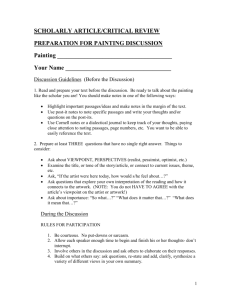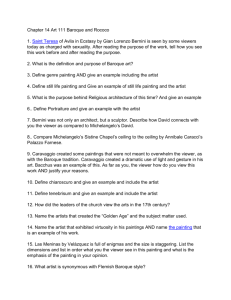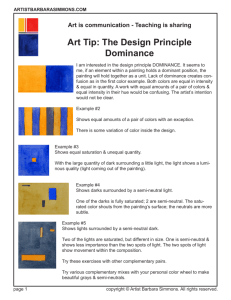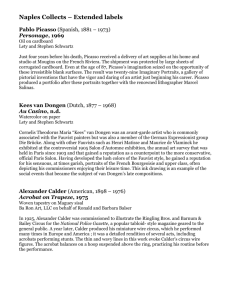Modern art - WordPress.com
advertisement
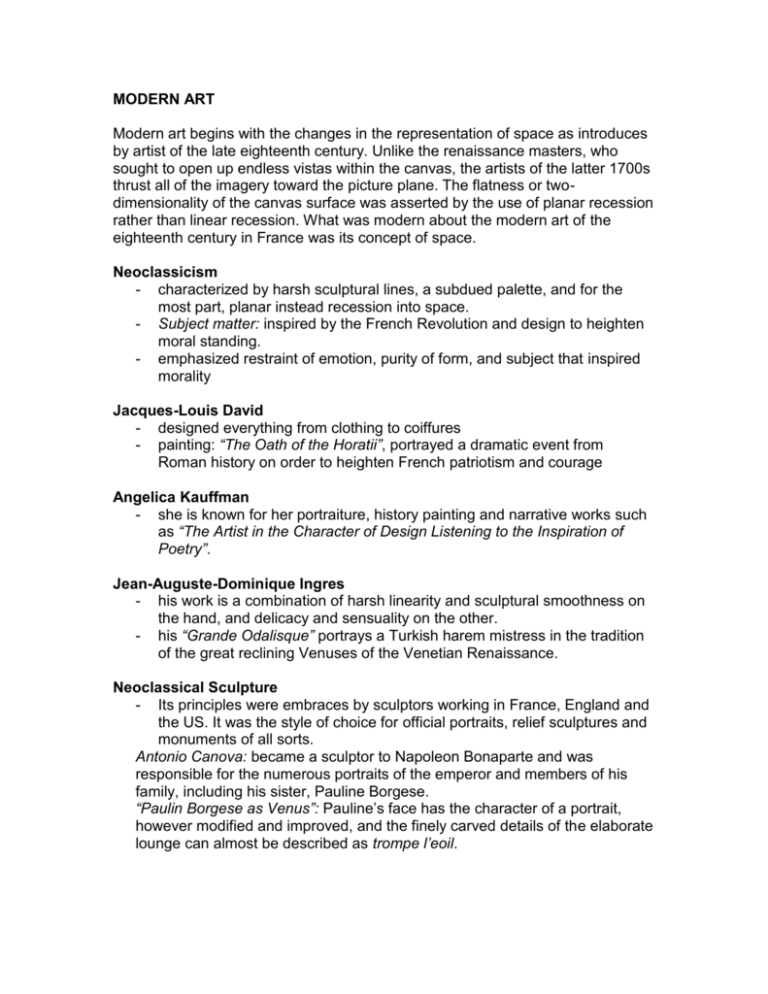
MODERN ART Modern art begins with the changes in the representation of space as introduces by artist of the late eighteenth century. Unlike the renaissance masters, who sought to open up endless vistas within the canvas, the artists of the latter 1700s thrust all of the imagery toward the picture plane. The flatness or twodimensionality of the canvas surface was asserted by the use of planar recession rather than linear recession. What was modern about the modern art of the eighteenth century in France was its concept of space. Neoclassicism - characterized by harsh sculptural lines, a subdued palette, and for the most part, planar instead recession into space. - Subject matter: inspired by the French Revolution and design to heighten moral standing. - emphasized restraint of emotion, purity of form, and subject that inspired morality Jacques-Louis David - designed everything from clothing to coiffures - painting: “The Oath of the Horatii”, portrayed a dramatic event from Roman history on order to heighten French patriotism and courage Angelica Kauffman - she is known for her portraiture, history painting and narrative works such as “The Artist in the Character of Design Listening to the Inspiration of Poetry”. Jean-Auguste-Dominique Ingres - his work is a combination of harsh linearity and sculptural smoothness on the hand, and delicacy and sensuality on the other. - his “Grande Odalisque” portrays a Turkish harem mistress in the tradition of the great reclining Venuses of the Venetian Renaissance. Neoclassical Sculpture - Its principles were embraces by sculptors working in France, England and the US. It was the style of choice for official portraits, relief sculptures and monuments of all sorts. Antonio Canova: became a sculptor to Napoleon Bonaparte and was responsible for the numerous portraits of the emperor and members of his family, including his sister, Pauline Borgese. “Paulin Borgese as Venus”: Pauline’s face has the character of a portrait, however modified and improved, and the finely carved details of the elaborate lounge can almost be described as trompe l’eoil. Neoclassical Architecture - also dominated architectural design in France, England and America. - Benjamin Henry Boneval Latrobe : was a British-born American architect best known for his design of the United States Capitol. He combined elements of the Ionic order for the senate chamber and Corinthian capitals for the House of Representatives. Romanticism - sought extreme of emotion enhanced by virtuoso brushwork and a brilliant palette - it is an international artistic and philosophical movement that redefined the fundamental ways in which people in Western cultures thought about themselves and about their world. 2 major proponets of the romantic style in France: 1. Théodore Géricault: the depiction of nature as unpredictable and uncontrollable was his favorite theme “Raft of the Medusa”: he used to opposed the French Monarchy it to call attention to the French government; his most controversial and political work 2. Eugène Delacroix: he believed that painting was nothing without drawing; “The Death of Sarnapalus”: depicts the murder-suicide of an Assyrian king who rather that surrenders to his attackers, set fire to himself and his entourage.. Francis Goya - Considered the greatest painter of the Neoclassical and Romantic period. - Paintings and prints foreshadowed the art of the nineteenth century Impressionists. - Best known for his works with political overtones, ranging from social satire to savage condemnation of the disasters of war - “The Third of May”: Goya, focuses on viewers attention on a single moment in the violent episode - Devoted much of his life to graphic representation of man’s inhumanity to man. The Academy / Academic Art - the style and subject matter were derived from conventions - Had maintained a firm grip on artistic production for more than two centuries Adolphe William Bouguereau - one of the more popular and accomplished Academic painters - paintings are religious and historical in a grand classical manner - most famous for his meticulously painted nudes and mythological subjects. “Nymphs and Satyr”: nearly photo-graphic in its refined technique and attention top detail Realism The modern artist chose to depict subjects that were evident in everyday life, They respected the reality of the medium they worked with. Instead of using pigment merely as a tool to provide an illusion of three-dimensional reality, they emphasize emphasized two-dimensionality of the canvas and asserted the painting process itself. Honoré Daumier - The Third – Class Carriage - of all the modern artist of the mid-nineteenth century , he was perhaps the most concerned with bringing to light the very real subject of the plight of the masses - known for his lithographs (is a method for printing using a stone or a metal plate with a completely smooth surface) although he was also an important painter - brought to his works on canvas the technique and style of a caricaturist. Gustave Cuorbuet - Father of realist movement - “The Stone-Breakers”: objects of public derision. Coubet was moved to paint the work after seeing an old man and a young boy breaking stones on a road side. - So common a subject was naturally criticized by contemporary critics, who favored mythological or idealistic subjects. Edouard Manet - According to some art historians, he is the artist responsible for changing the course of the history of painting Instead of beginning with a dark under painting and building up to bright highlights Began with a white surface and worked to build up dark tones Did not model his figures with a traditional chiaroscuro. Instead he applied his pigments flatly and broadly “Luncheon on the Grass”: stands as a pivotal work in the rise of the Impressionist movements; takes place in a woodland setting Most important influence on the French Impressionist painter, a group of artist advocated the direct painting of optical impressions. Rosa Bonheur - one of the most successful artists working in the second half of the nineteenth century stunned human objects in favor of animals “The Horse Fair”: panoramic scene of extraordinary power, inspired by the Parthenon’s horsemen frieze; the dramatic contrast of light and dark underscore the struggle between man and beast, while the painterly brash-work heighten the emotional energy in the painting Impressionism A group of younger artists were banding together against the French art establishment, suffering from lack of recognition and vicious criticism nay of them lived in abject poverty for lack of commissions. Yet they stand today as some of the most significant and certainly among the most popular artist in the history of arts. They were called the Impressionists. The word impressionism suggests lack of realism and realistic representation was the standard of the day. Through intensive investigation, they arrived at awareness of certain visual phenomena. The actual color of these objects is altered by different lightning effect. Claude Manet - the most fervent follower of Impressionist techniques - Impression: Sunrise - The dissolution of surfaces and the separation of light onto its spectral components remain central to Monet’s art; dramatically evident in a series of canvases depicting Rouen Cathedral from variety of angles, during different seasons and times of day. Pierre-Auguste Renoir - most significant figure painter - Was interested primarily in the effect of light as it played across the surface of object. - Illustrated his preoccupation in one of the most wonderful paintings of the Impressionist period, Le Moulin de la Gallette. - Painted all details that imprint such scene Berthe Morisot - In Morisot’s Young Girl by the Window surfaces dissolve into an array of loose brushstrokes, applied, it would seem, at a frantic pace. The vigor of these strokes contrasts markedly with the tranquility of the woman’s face. Edgar Degas - Was a superb draftsman who studies under Ingres - While in Italy, he copied the Renaissance masters. Intrigued by Japanese prints and the new art of photography Painted “The Rehearsal” Influences by the developing of art photography, and the camera’s exclusive visual field served as a model for the way on which he framed his own paintings. Photography The influence of the new medium of photography can readily be seen on may examples of impressionist painting. Photography improved rapidly for the next 50 or 60 years thereafter - faster emulsions, glass-plate negatives, better camera lenses – and photographs became more widely available and affordable to the general public. The concept of visual record drove portraiture and photojournalism while “art photography” aimed to replicate the pictorial aspects of painting. The first successful daguerreotype, a still life composition of the artists’ studio, was created by Jacques-Mande Daguerre, a landscape painter. Portraits By the 1850s, photographic technology and a growing middle class in the wake of American and French revolutions came together to create a burgeoning business on portrait photography. Having likeness of oneself was formerly reserved for the wealthy, who could afford to commission pained portraits. It became the democratic equalizer. The rich, the famous and average bourgeois citizens could now preserve their presence for posterity. - Nadar: imitated booth nature and the arts, using costumes and props that recall Romantic paintings or sculpted busts caressed by flowing drapery. For Sarah Bernharth’s portrait, Nadar arranged a mass of voluptuous drapery onto a pedestal of sorts of the extraordinary beauty and intellect of the actress. The smooth textures underscore the pensive, brooding countenance associated with her dramatic style. Photo journalism In the nineteenth century, illustrations in newspapers and magazines were few and primarily derived from engravings of drawings. Photography revolutionized the way that news media brought visual images of events to the public. Pioneers such as Mathew Brady and Alexander Gardner user camera to record scenes of the U.S. Civil War. Their work focused on staged portraits of officers and soldiers, of daily life on the camps along the lines and as in Gardner’s Home’s of “Rebel Sharpshooter, Gettysburg”, of harsh evidence of gruesome death and devastation of war. It’s unlikely that any of them expected that their more graphic images would serve any purpose other that n historical record. Art Photography Photography as an art form made a significant leap forward with Loius Lumière’s introduction of the auto chrome color process in 1907. Lumière’s auto chrome photographs such a ”Young Lady with an Umbrella ”are akin to paintings by Postimpressionist artist Georges Seurat, an avid student of color theory, as well as to works by other photographers in the pictorial style. Lumière’s technology was not replaced until 1932, when Kodak began to produce color film that applied the same principles to more advanced materials. Post Impressionism The Impressionists were united in their rejection of many styles and subjects of art that preceded them. During the latter years of the nineteenth century a group of artist that cane to be called Postimpressionists were also united in their rebellion against that which came before them- in the case, Impressionism. The postimpressionists were drawn together by their rebellion against what they considered as an excessive concern for fleeting impressions and a disregard for the traditional compositional elements. Georges Segurat - ”Sunday Afternoon on the Island of on the Island of La Grande Jatte” - The small brushstrokes are there and also complementary colors. The subject matter Is entirely acceptable within the framework of Impressionism. - The technique he used was pointillism, after his application of pigment in small dabs, or points of pure color. Paul Cézanne - Credited with having led the revolution of abstraction of modern art from those first steps - Most significant stride toward Modernism, however, was a drastic collapsing as space, seen in works such as ”Still Life with Basket of Apples”. - He moved around his subject, painting not only the objects but the relationship among them. - Asserted flatness the flatness of the two-dimensional canvas by eliminating the distinction between foreground and background and at times merging the two. This perhaps the most significant contribution to future modern movements. Vincent Van Gogh - One of the most tragic and best known figures in the history of art - Most of his beloved canvases were created during his last 29 months - In ”Starry Night”, an ordinary painted record of a sleepy valley town is transformed to a cosmic display of swirling fireballs that assault the - blackened sky and command the hills and cypresses to undulate to their sweeping rhythms. Laden with vibrant yellows, blues, and greens. Paul Gaugin - Relied on board areas of intense color to transpose his innermost feeling to canvas. - Developed a theory called Synthetism, in which he advocated the use of broad areas of unnaturalistic color and primitive or symbolic subject matter. - His ”Vision after the Sermon”, one of the first canvases to illustration his theory, combines reality with symbolism. Henri de Toulouse-Lautrec - Used his talents to portray life as it was in this cavalcade of cabarets, theaters, cafes, and bordellos – sort of seamy, but also vibrant entertaining, and populated by real people - In ”At the Moulin Rouge”: Japanese inspired oblique perspective we found earlier in his poster work - The fabric of the entertainer’s dress is constructed with fluid Impressionistic brushstrokes, as are the content of the bottles, the lamps in the background, - The strong outlining as the entertainer’s face marks the work of the Impressionist Expressionism - A polarity existed in Postimpressionism that was like the polarity of the Neoclassical – Romantic period - Artist used color and line to express inner feelings Edvard Munch - Abandoned a light palette and lively subject matter in favor of a more somber style that reflected an anguished preoccupation with fear and death - Looked for symbols of isolation that would underscore his own sense of loneliness, or themes of violence and perverse sexuality that reflected his own psychological problems - ”The Scream”: is one of his best-known works - It portrays the pin and isolation that became is central themes Käthe Kollwitz - Sought universal symbols for inhumanity, injustice and humankind’s destruction of itself - ”The Outbreak”: represents the sixteenth-century War American Expatriates Mary Cassatt - She was a figure painter whose subjects centered on women and children - ”The Boating Party”: has flat planes, broad areas of color, and bold lines and shapes, illustrates Cassatt’s interest and skill in merging French Impressionism with elements of Japanese art James Abbott McNeil Whistler - Painted one of the best-known compositions in the history of art - ”Arrangement in Black and Gray”: The Artist’s Mother: exhibits a combination of candid realism and abstraction that indicates two strong influences on art: Courbet and Japanese prints Thomas Eakins - Most important American portrait painter of the nineteenth-century was Thomas Eakins - Devoted his career to increasingly realistic portraits - ”The Gross Clinic”: stems from Eakins’s endeavor to become fully acquainted with human anatomy by working from live models and dissecting corpses. Thomas Cole - Fond of landscape painting and settles in New York ] - “The Oxbow”: records a natural oxbow formation in the Connecticut River Valley - Combines a vast, sun- drenched space with meticulously detailed foliage and farmland Bible Quilt: The Creation of the Animals - by Harriet Powers - its 15 squares of cotton appliqué weave together stories from the Bible with significant events from the family and community of the artist - demonstrating both African and African American influences; they are notable for their bold use of these techniques in storytelling. - left to right: the fourth square: is a symbolic depiction of Adam and Eve in the garden of Eden. A serpent tempests Eve beneath God’s all-seeing eye and benevolkant hand. - Sixth square: Jonah is swallowed by a whale - Last square: stylized depiction of the Crucification Unity in the quilt is created by a subtle palette of complementary hues and by simple, cutout shapes that define celestial orbs, biblical and familial characters and biblical and local animals. The quilt has an arresting combination of widely known themes and private events known to the artist and her family. Some are records of meaningful days. Eleventh square: A woman is shown frozen at a gateway while at prayer. All bluebirds are killed. Thirteenth square: includes hog that was said to have run 500 miles from Georgia to Virginia, and the fourteenth square depicts the creation of animals in pairs. The Birth of Modern Sculpture Auguste Rodin - The Burghers of Calais - Represents all of the innovations of modernism thrust into three-dimensions. He work commemorates a historical event in which six prominent citizens of Calais offered their lives to the conquering English so that their fellow townspeople might be spared. - he Preferred modeling soft materials for carving because they enabled him to achieve highly textures surfaces that captured the play of light, much as in an Impressionist painting. Architecture Nineteenth-century industrialization enabled cast iron and steel to emerge as widely used building materials. They were two of a number of innovative structural materials that would change the face of architecture. Eiffel Tower - Designed by Alexandre Gustave Eiffel - It was constructed in Paris in 1889 for another world Exposition. - Has become the single most recognizable symbol of Paris Wainwright Building - is a 10-story red-brick landmark office building at 709 Chestnut Street in downtown St. Louis, Missouri. - Architect: Louis Sullivan - It is described as "a highly influential prototype of the modern office building" by the National Register of Historic Places Modern Art De Claro, Paula Aquino, Raymond Perducho, Jim Eric MMA 1-1



